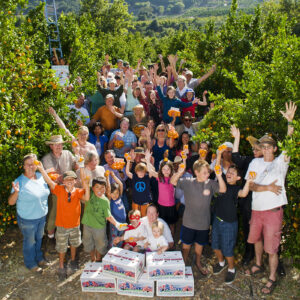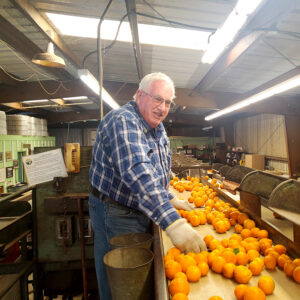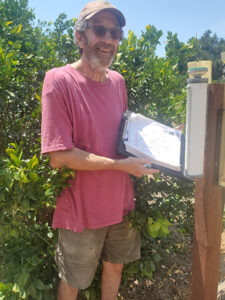FEATURE | By Kit Stolz
Will the Pixie Survive?

Ojai Valley Pixie Growers Association
This past July, observant Ojai residents noticed that an entire orchard of Pixie tangerines bordering on Highway 150 not far from Soule Park had been picked and then dropped to rot on the ground. Thousands of pale orange tangerines lay abandoned in untidy profusion at the base of the glossy-leaved trees. A cloying sweetness filled the air: flies buzzed. Nobody was happy to see the waste of thousands of pounds of fruit, especially in a pandemic when — according to Food Share, Ventura County’s leading food bank — the need for food for the hungry was up 138 percent in 2020 in the county.
When an Ojai environmental writer named Pete Deneen posted pictures of the grounded Pixies on Instagram, comments poured in from residents troubled by the waste. Some wanted to volunteer to help, or in some way give the fruit away.
“This is so sad,” wrote Jess Purple, a photographer in Ojai, adding that she had called a local non-profit to donate the fruit from a few trees, but would have had to wait months.
Deneen said that he had heard many explanations for the wasting of the fruit and the large amount of water — approximately ninety gallons of water per pound of fruit — it took to grow the fruit. He still finds it hard to understand, given the need.
“Food banks and restaurants lack the personnel to come and harvest and in our litigious culture it is a liability to ask people to come pick,” he said. “Maybe this farmer did the best thing they could in a system that perversely prioritizes slim margins of profit over all else.”
In fact the property near Soule Park was one of four orchards that the Ojai Pixie Growers Association was forced to “pick to the ground” this year, for the first time ever in its quarter century of existence as a co-operative association. In a year-end letter to the Ojai Pixie growers, founder Tony Thacher wrote that “for the first time we could not find homes for all of the crop.” Thacher said that they could not sell all the crop; nor could they give it away, as “Food Share and Food Forward were overloaded with surplus tangerines.”
Food Share did accept a donation of 22,000 pounds of the fruit, about three truckloads, said operations executive Brian Fisher, but that figure was dwarfed by the over 100,000 pounds of fruit that the Ojai Pixie growers had to drop to the ground.
The Ojai Pixie farm near Soule Park belongs to Larry and Pat Hartmann, who have been growing Pixies for about 15 years, but this year had to drop their entire crop.
“We had to drop our crop because there was no market for it all year,” Pat Hartmann said. “It’s in part pandemic-related. We couldn’t get trucking to send to a customer in Canada, and the schools, which used to have a program to give Pixies to the kids for their lunches, weren’t in session this year. It’s kind of sad, because we love the Pixie fruit, and it takes about six years before you can get your first crop. I really don’t have a lot of hope for the Pixie in the future.”
Carly Ford, a grower in the Camino Cielo area, also saw their crop picked to the ground, because the crop could not be sold or given away.
“It’s pretty sad to see that orange carpet,” she said. “The last two years have been really bad,” she said. “A lot of it has been supply chain issues, and covid, and exports haven’t been working out. The fruit has been good, but sales have been tough because transportation is a big part of it. We’re also very worried about water. We don’t know what we’re going to do if we can’t water.”
“This was the first year that Ojai Pixie Packers dropped fruit to the ground for lack of a market,” said Emily Ayala, a leading deal-maker for the Ojai Pixie Growers Association.
TOO MANY TANGERINES

Pixies at market
That was the story for Pixies and mandarin tangerines in California this year, Ayala said: too much fruit and too few buyers. Ayala talks softly, but when she speaks of the harvest, her voice hardens.
“All the citrus companies, including the Cuties and Sunkist, had too much fruit,” she said. “Statewide much of the late-season mandarin crop was dumped, either left on the tree, dumped at the packing house, donated to food pantries or dropped on the ground. In some instances orchards were bulldozed as the double whammy of not having enough irrigation water also came along this year.”
Emily Ayala’s father is Tony Thacher, who in his fifty-plus years of management for the Friend’s Ranch citrus orchards, has seen nearly every crisis that can afflict an orchard in Ojai, from floods to fires, freezes to droughts, pests to pesticide protests. In an interview in the Friend’s Ranch packing house he recalled with a trace of amusement a conversation with a new farmer facing for the first time the harsh reality of an existential threat to the famous Ojai Pixie tangerine.
“A new grower who had bought a few acres of Ojai Pixies came up to me after a meeting (of the Ojai Pixie Grower’s Association),” Thacher said. “I think he realized all of a sudden that he might have made a serious mistake, buying an orchard at this time, and he said to me “What are we going to do if there’s no water?”
Thacher cocked his head at the possibility, as if the thought had just occurred to him.
“Well, if there’s no water, I guess we’ll all have to move to British Columbia,” he said, with a trace of sarcasm. “It’s like owning a beachfront home worth a bazillion dollars as the sea level is rising. When do you know when to go?”
TONY THACHER — ONE OF THE FIRST
PIXIE GROWERS

Tony Thacher

Jim Churchill, Pixie pioneer
Thacher comes by the long view honestly. As a young man he pursued a graduate degree in geology at University of California-Berkeley, and still talks with fascination about the movements of the earth’s tectonic plates. But in the late 1960’s he married Anne Friend, a daughter of Elmer Friend, a pioneering family in Ojai who in 1871 launched the innovative orchard called Friend’s Ranch. Before they could finish their graduate degrees at UC Berkeley, fate intervened, in the form of the catastrophic 1969 floods that devastated Ojai.
“In the early days everyone sold their own citrus, and at that time Sunkist wasn’t interested in tangerines, so my father-in-law (Elmer Friend) stayed independent,” Thacher said. “Then in 1969 the packing house and much of the orchard here went down the river (in the floods), and Anne and I moved back from Berkeley to help rebuild. We came down in late summer to help out as Anne finished her thesis. We ended up staying and having a couple of kids.”
Thacher still works early mornings at the Friend’s Ranch packing house in close collaboration with his daughter Emily. He first planted the new variety called the Pixie in the 1970s, after the flood damage, drawing on the experience of his father-in-law Elmer Friend and local grower Frank Noyes, whom Thacher describes as “a man with a curious mind.” Working in partnership with UC citrus researchers, Noyes had grown over time several experimental varieties in Ojai, including a little-known new variety called the Pixie.
“And when the (Pixie) trees got bigger, these two critters,” he said, nodding at his grown daughter Emily, sitting next to him, speaking of her and her brother George — “would eat about a quarter of the tree. After they were done it looked like the deer had gone through.”
Despite the popularity with his children and with local customers, Thacher says that the present-day popularity and fame of the Pixie came slowly.
“In the early days, for six or eight years, produce managers basically thought we were nuts,” Thacher says. “They had absolutely no use for Pixies. For one, they’re alternate bearing, meaning that one year they produce heavily, and the next year much less. And tangerines are microclimate dependent: grow a Pixie in Ventura and it’ll taste like water. It’s not hot enough. Ojai has the right amount of heat and the right amount of temperature variability, as it cools off at night. This year the Pixies tasted really good, because we had a hot summer last year, and the heat we’ve having now will make next year’s fruit taste really good.”
Nine years later, before the Pixie became known as a fruit, came another catastrophic flood, this time one driven by a record-breaking El Niño rainy season.
“Most of the trees we planted after the ‘69 flood were washed out again, along with a tremendous amount of material, sediment as well as trees,” recalls Thacher. “If you get a big flood year and go to the beach you can see citrus trees washed up from Goleta or Ojai.”
In the early days, at Friend’s Ranch and other Ojai orchards, fruits such as Valencia oranges, lemons, and bacon avocados dominated the Ojai agricultural scene. The market for bacon avocados began to collapse in the late ‘70s, as the avocado industry moved to the Haas variety, forcing local farmers to consider other possibilities.
“There wasn’t a great market for bacons and we were casting around for other things,” Thacher said. “We started to go to more Pixies.”
About this time in Ojai a new farmer, Jim Churchill, a young college graduate and writer managing a 37-acre East End orchard for his father, began to question the practices he had been taught in order to manage an orchard of bacon avocados. He had thousands of trees, most afflicted with a root rot, and had no idea what to do. He realized he might never make money from the orchard.
“One day I’m over at Friend’s Ranch visiting and I’m talking to Tony Thacher, and I pull something out of a bin and I peel it and I put it in my mouth and I say, ‘Tony, what is this?’ And he says, ‘That’s a Pixie tangerine.’ And I say, well, do you sell them? And he says, ‘Well I only have two trees and by the time I’m done selling my Darcies, the kids have eaten all the Pixies.’ And if you had been there, you would have seen a lightbulb go off over my head.”
Ten years later, in 1990, according to records now kept by Emily Ayala, Ojai still had just an acre-and-a-half planted in Pixies, mostly at Friend’s Ranch, with a new planting of Pixies at Churchill’s orchard. Nonetheless, Churchill bet big on the little-known variety, ordering 150 trees at a time in the early 1980s.
“I started bringing fruit to the office and people went nuts,” Churchill said. “So I tried to sell my fruit and I get nowhere. I went to every produce manager I could find, and nobody will buy the Pixie, because it’s a little bit small, and it doesn’t get ripe during the traditional tangerine season. Nobody at that time wants tangerines that ripen in April. I have one customer, at a produce stand on Montana Avenue (in Santa Monica) and he buys like 14 cartons every two weeks and pays me about 15 cents a pound. It’s pretty discouraging.”
Desperate for outlets for his growing Pixie crop, Churchill reached out beyond Southern California and called on the produce manager of the Monterey Market in Berkeley. Lisa Brenneis, then his wife, who grew up in Berkeley, convinced Churchill to try Bill Fujimoto, an enthusiastic buyer of seasonal fruits and vegetables at the Monterey Market. Churchill sent Fujimoto a box of Pixies, tied up with twine, and started calling.
“It took me a week to get Bill on the phone, but finally I do get him, and I have a conversation with him that changed my life,” Churchill says. “He just asks me how much we got, and he takes me through the procedure for a standard pack, the sizes and the quality, how much goes in a standard box, and then the trucking and at the end of the conversation he orders a pallet. A pallet is 63 cartons, or 1,575 pounds. And he says, ‘I’ll pay you 80 cents a pound.’ Wow. So all of a sudden I’m in business.”
What Churchill didn’t realize at first, as he sent his entire Pixies crop to Berkeley for the next six years, was that Monterey Market had become a nexus for the burgeoning “farm-to-table” cooking movement in California. Chefs from all over the Bay Area would gather in Fujimoto’s back room to sample the latest and best of fresh fruits and vegetables from farms throughout California. Within a couple of years, the Pixies were “discovered” by restaurateur Alice Waters and Lindsey Shere, the pastry chef at the famously influential Chez Panisse in Berkeley. The Pixies were put on the dessert menu without preparation or ornamentation, as “Jim Churchill’s Pixie Tangerine.” They can still be found there in season.
“Jim and everyone in the citrus business in Ojai benefitted from a certain opening in the market at that time,” commented Mike Sullivan, a ranch manager who has worked with Churchill and several other farmers in Ojai and Ventura County. “This was the right time and the right place for the Pixie, but it wasn’t all luck. Jim came from outside farming, and he has a different perspective that allowed him to do some different things with Pixies and citrus in general.”
Thacher admired Churchill’s ability to find new customers for his Pixie, including a Japanese importer of fine foods marketed under the name of Reputation Brand, whom Churchill met through a Japanese tradesman in Santa Paula. Decades after making this connection, the Churchill Orchard still every year sends a shipment of Pixies to Japan by freighter.
“Jim is a great salesperson,” said Sullivan. “But it’s because he believes in what he’s selling. He doesn’t sell stuff he doesn’t like.”

Bill Fujimoto and Lisa Brenneis. Bill’s advocacy opened pixies to a wider market
In the l990s, with the imprimatur of Chez Panisse as a badge of honor, the Pixie tangerine rode a wave of popularity and praise, buoyed by stories and kudos from the likes of the Los Angeles Times, Gourmet, Sunset and The New Yorker. Soon other well-established local growers began planting Pixie trees by the hundreds, and in the 1990s growers came together in a handshake deal to form a growers association to market the fruit, which was founded by Thacher, Churchill, the late Mike Shore, and Bob Davis, an early Pixie farmer in the East End.
“For maybe two years, Tony sells all the Pixies for the people on the west side, and I sell for all the people on the East End,” said Churchill. “We have different price structures and different packing houses and different customers and it just begins to seem silly and so we decided we should get together and brand ourselves as the Ojai Pixie, because Ojai is famous for really good citrus. And that’s how the Ojai Pixie Growers Association starts.”
Within a decade of its founding, the co-operative was selling well over half a million pounds of Pixies annually and returning nearly 80 cents a pound to the growers, boosted substantially by a deal with the national distributor Melissa’s. Despite floods, droughts, and fires, the volume of Pixie sales continued to grow, until in 2015 and 2017 the growers sold 90,000 cartons of Pixies, or about 2.5 million pounds. This was a high-water mark and a good number for a small town.
THE STRUGGLE TO COMPETE WITH THE CORPORATE BRANDS
But with prominence came competition. Beginning in 2001, two huge conglomerates in the Central Valley, Sun Pacific, leaded by Berne Evans, and Paramount Citrus, controlled by Linda and Stewart Resnick, combined forces to plant hundreds of thousands of mandarin citrus trees to launch a small, seedless, easy-to-peel brand dubbed “Cuties.”
It looked to the Pixie growers like a rip-off.
“They poached all our ideas,” said Thacher. “We were sweet, petite, and child-friendly, and at the OPGA, we had a budget of about $6,000 for bumper stickers and some hats. I can remember the Halos launched on the East Coast with a $20 million marketing budget.”
Churchill echoes the charge, and adds detail.
“‘Cuties’ are a really, really brilliant sort of extension and commercialization of what Pixies are,” said Churchill. “They’re not a variety of fruit, they are an intellectual property, and as an intellectual property, they are whatever variety the makers put in the box. In the springtime they use a W. Murcott mandarin, or a Tango, which is a new variety developed by the University of California. And then in the fall they import clementines from the southern hemisphere, so the Cuties are year round.”
Churchill, who has represented seasonal Pixies in stores around the country, has found himself offering Pixie samples to shoppers just feet away from a massive display of Tangos priced at one third the cost of his fruit. He has no illusions about the one-sidedness of the competition between a few dozen growers in Ojai and huge vertically-integrated conglomerates in the Central Valley.
“From the point of view of the Ojai Pixies, what matters is that in their first spring they planted 500,000 trees, dwarfing the total number of Ojai Pixie trees by a factor of at least ten, and they keep on planting, in California and citrus growing regions across the Southern Hemisphere,” he said. “Their aim is total market domination.”
Churchill and Brenneis, in order to distinguish their Pixies from the cheaper imitations, decided to take Churchill Orchard organic. Few Ojai growers have followed their lead, but even a seasoned and successful farmer such as Jim Finch, who grows Pixies and other citrus in Ojai and Fillmore, worries about the future of the Pixie in a competitive landscape dominated by massive quantities of Cuties, Halos, D’Lites, Bee Sweets, and Tangos, among others.
“I’m concerned about the future of ag in Ojai,” Finch said. “So much of our fruit is now going up against foreign competition, much more so than just five years ago. We saw four million cartons of lemons imported from Argentina this year.”
CAN THE PIXIE SURVIVE?
For Lisa Brenneis, who still runs the mail order operation for Churchill Orchard, despite no longer being married to Jim Churchill, the crises can seem perpetual.
“It’s like a carousel of existential threats,” she said. “Lack of water, lack of labor, deadly pests — it’s never ending.”
Churchill agrees.
“I should say I don’t give us very many more years,” he said. “There’s not any water. I mean, I just don’t see any way around that fact. After this year, unless we have a wet winter, I don’t see us surviving for long.”
Ever since the floods of 2005 filled Lake Casitas, the reservoir has been in decline, falling below 50 percent in 2016, and standing this fall at about 33 percent. The threat of a Stage Four drought condition with sharp mandated cutbacks to both residential and agricultural customers helped motivate a strong conservation response from the community, which reduced consumption by more than 30 percent in ten years. But this fall Ventura county remains in “extreme” drought, according to the National Drought Monitor.
John Krist, executive director of the Ventura County Farm Bureau office, is retiring this year after 14 years with the organization. He also fears for agriculture in Ojai. Along with resistance to the spraying required for orchards threatened by the Asian Citrus Psyllid, he points to corporate competition, the decline of experienced local agricultural workers, and lack of water. He also mentions an often-overlooked factor: droughts such as Ojai has experienced in recent years, with high temperatures, dry soil, and little humidity, intensify what scientists call “evaporative demand,” which further stresses plants.
“Warmer air is thirstier air,” he said. “We’re seeing this playing out in the wildfire arena. It’s been so hot and dry for so long that the moisture levels in fuels is falling to unheard-of lows. With warmer weather and more evaporative losses, if it only rains five inches in a year and you’re farming lettuce, you can let it go for a year, but citrus trees need more water to survive.”
For the first time in decades of production, this year Churchill’s orchard exceeded his agricultural allotment of water from Casitas. He incurred a penalty of about $3,500, a bit less than ten percent of his annual billing, despite tracking his usage daily on every irrigation line. He points out that his orchard is not the only one under stress.
“If you drive around the East End with your eyes open, you’ll see a lot of orchards that are dying,” he said. “People are just turning off the water.”
A NEW CONSERVATION FOR AGRICULTURE

Pixie tangerines at market
Concerned by the escalating threat to Ojai’s agricultural lands and character, Tom Maloney, executive director of the Ojai Valley Land Conservancy, has been researching the possibility of establishing a conservation easement program for farmers. He has been talking to local and state officials, as well as many Ojai farmers including Emily Ayala, Churchill, and Roger Essick.
“It’s exploratory at this stage, driven by the scarcity of water,” Maloney said. “Is there a way to marry the preservation of our rural and agricultural character with a more sustainable use of water, to retain what makes Ojai a special place?”
Maloney said that this is a new frontier for conservation easements, without much of an established model to draw on, but he believes it’s becoming necessary to preserve Ojai.
“The bottom line is that we are recognizing how challenging it is now for a Pixie or an avocado grower,” Maloney said. “The reality is that you can’t have an Ojai Valley Land Conservancy and not be focused on agricultural sustainability. We can’t fulfill our mission of preserving the wildlife and views here without thinking about a landscape-level threat to the character of the valley.”
Bolstering Maloney’s effort is Andy Spykra, a conservation specialist with the local office of the state resource conservation district. Spykra says he often fields calls from new landowners in Ojai, who buy an orchard and then discover, with water rights issues, Asian Citrus Psyllid requirements, and countless other challenges, that it’s more than they want to handle.
“It’s a confusing process and often they feel as if they’ve bitten off more than they can chew,” he said. “I get calls asking about a land retirement program for orchards — what would that look like?”
To avoid seeing the orchard torn out and pulped, leading to soil erosion and the potential loss of irrigated orchards to buffer the threat of wildfire around Ojai, Spyka imagines converting orchards to a beneficial landscape, with funding from a variety of partners.
“Instead of allowing orchards to go into a moonscape, we are exploring how to rest people’s water rights, in order to increase downstream water flows, while also promoting an idea of rewilding an orchard,” he said. “We would like to see a one-stop shop for landowners. If they tell us, “Hey, I got this orchard, I don’t know quite what to do with it,” we would encourage them to come in for help with the permitting and make it an easy process, to retire it for the landowner and help fund a program to share the costs.”
Spyrka encouraged interested agricultural landowners in Ojai to give him a call, to be added to a short list, saying that he hopes to find funding for an initial effort by the end of the year.
“I’ve talked to state-level officials about funding and there is interest,” he said. “It’s a different kind of conservation idea. We need different ideas.”
OJAI GROWERS CUT BACK — AND HOPE FOR RAIN
While some growers are cutting back on expenses and hoping for a wet winter, which would mean bigger and better and easier-to-sell fruit, other growers are reducing the size of their Pixie plantings. Brent Jacobs, who in 2017 bought a Pixie orchard along Highway 33 not far from Friend’s Ranch, said that after he lost a substantial portion of his trees to the Thomas Fire, he decided to replant with avocados and blackberries.
“I haven’t had a successful crop since 2018,” he said. “This year we had a myriad of problems, a perfect storm of issues, but most of all we had a glut of mandarins. Not necessarily of Pixies, but of mandarins. The Cuties, the Halos and those other varieties have some of what Pixies have — they’re easy to peel, they’re used as a snack fruit, they don’t have seeds — but they don’t taste as good. But with the glut of mandarins, and the supply chain difficulties we had getting our fruit to customers, it’s been a very expensive hobby for me the past couple of years.”
Jim Finch, a Ventura County farmer with experience growing many different crops, said that he, too, had reduced his Pixie plantings.
“I’m removing Pixies for lack of performance,” he said. “I will replace them eventually. What our water will cost in Ojai in a few years concerns me. I think the Pixie will survive, but it’s a niche play for a niche market, and it’s a small niche.”
Emily Ayala fears that after 13 decades of history in the valley, Ojai agriculture is fading away.
“With real estate prices as they are, when orchards disappear, they won’t come back,” Ayala wrote in a guest editorial this summer. Her father warns even more bluntly that the pressures on Ojai agriculture could soon push it over the edge into unsustainability.
“It’s poor prices and overproduction and no water,” Thacher said. “It’s people moving to Ojai to get out of the city and paying anything for land. It’s not going to be a slow walk of the lemmings to the cliff.”
Ben Faber, a long-term crop advisor for the University of California’s agricultural extension in Ventura County, said that Ojai farmers feel “beleaguered.” Not only has their best crop been undercut in the market by mandarin growers, but while contending with rising prices for labor and transportation, and a diminishing supply of water, they also face criticism at home from neighbors who object to mandated spraying for pests.
Faber thinks they will find a way.
“The thing about Pixie growers is that they have always been really innovative,” Faber said, “it’s a niche market, but they have been really clever about finding that niche. It’s a great piece of fruit, with a long harvesting period, and if we can get a handle on the Asian Citrus Psyllid, which I think we are, I think the Pixie has a future.”
Faber thinks Ojai could do more for its farmers, for one, just by choosing the fruit of their labors.
“Eat more Pixies!” he said. “Don’t buy those Halos and Cuties! Buy local, people. It’s right here and it’s good.”


Outstanding story. Great reporting.